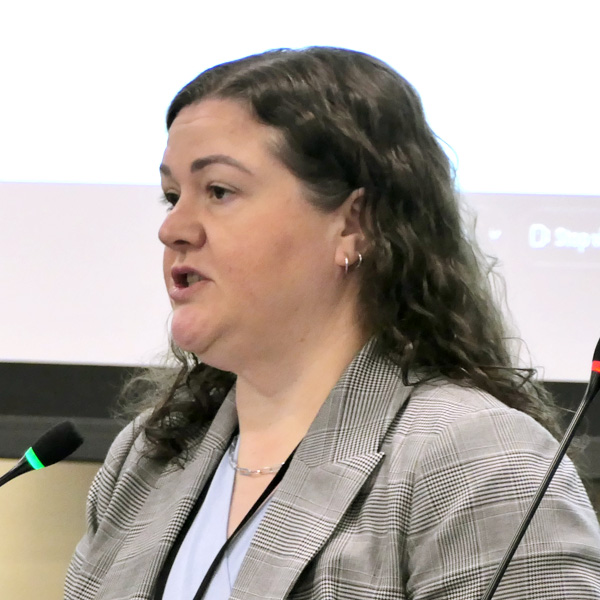PORTLAND, Ore. — The Bonneville Power Administration’s biggest risks in joining SPP’s Markets+ come down to footprint size and the limited transmission connectivity between the Northwest and Southwest entities most inclined to join the market, agency executives said during a Nov. 4 press briefing.
BPA held the briefing immediately after a sometimes-contentious meeting where agency officials updated stakeholders on the day-ahead market decision process and discussed results from a new production cost model study estimating the agency’s potential economic benefits from participating in either Markets+ or CAISO’s Extended Day-Ahead Market (EDAM). (See related story, Rising Tensions Evident at BPA Day-ahead Markets Workshop.)
The study, prepared by Energy and Environmental Economics (E3), found that BPA stands to realize the greatest savings in a single West-wide day-ahead market and would earn significantly more financial benefits from EDAM than from Markets+ under the most likely scenario reflecting the commitments a handful of key utilities have already made to joining the CAISO-run market.
Despite those findings, BPA has said it plans to hold fast to its staff recommendation that the agency choose Markets+ for more qualitative reasons, such as its independent governance from the get-go and the market design established under that governance. (See BPA Sticks to Markets+ Leaning Despite Study Showing EDAM Benefits.)
“I think footprint is a fair issue [for risk in Markets+], especially when you look at production cost model studies,” Rachel Dibble, BPA vice president of bulk power marketing, said during the briefing. “That’s really where those [economic benefits] numbers come from … the size of the footprint.”
Dibble and acting BPA CIO Nita Zimmerman agreed that transmission connectivity between the two prospective Markets+ areas was another key point of risk for potential participants.
“It really impacts the ability for power to flow across the region,” Dibble said.
Dibble noted there is some connectivity between the Northwest and Southwest, but it’s “not particularly robust,” especially if NV Energy joins EDAM, a near certainty after the utility in May announced its intention to do so. (See NV Energy to Join CAISO’s Extended Day-Ahead Market.)
“More connectivity would be better, because it does give the chance to do more optimization across the two [regions], but there is some transmission” between them, she said.
“Flow will also go through California on California transmission as well,” Dibble added. “That’s still part of the market, because that transmission … also links the Northwest to the Southwest.”
Libby Kirby, BPA’s market initiatives policy lead, said the agency has few concerns about passing FERC market power screens under a scenario in which the two major parts of Markets+ are held together by limited transmission.
“One piece of the market design in Markets+ includes a ‘conduct and impact’ test,” Kirby said. “So it’s not just, ‘Is there the potential for market power?’ It’s like, ‘Are you actually impacting the price?’ So there’s kind of some additional steps that they check before they actually assess you for market power.”
During the workshop, some stakeholders pointed to the financial risk of BPA paying its $25 million share to fund the Phase 2 implementation phase of Markets+ if it later decides not to join the market, given that the funding is expected to be paid through future transactions in the market. Agency officials said the expense is worth ensuring the West has two viable day-ahead market options.
During the briefing, Dibble said she didn’t yet know when the $25 million would come due if BPA declined to join Markets+ and that such details would be worked out in the Phase 2 contract.
‘A Real Option’
Some workshop participants also expressed concern about BPA’s timeline for issuing a decision on its market choice, urging the agency to push back its May 2025 target to allow more time for legislative developments to play out around the West-Wide Governance Pathways Initiative.
Asked about the impact on the BPA decision timeline of FERC potentially issuing a second deficient letter on the Markets+ tariff, Dibble said: “It’s something we would have to play by ear. It depends on what’s in it, [and] how quickly it could be answered. But I think ultimately, until we have a FERC-approved market, we don’t have a market to join.”
Dibble pointed out that other Western entities aren’t waiting on BPA to make their market decisions. “And what concerns us is that Bonneville just gets pulled into whatever everyone else chooses, instead of it being a proactive choice that we are making based on what’s best for our customers,” she said.
“I don’t believe that creating a West-wide market is something that is Bonneville’s responsibility,” she added, reiterating a point BPA representatives have made throughout the agency’s decision process.
BPA recognizes the impact of its decision and wishes “no harm” to others in the Western Interconnection, Dibble said, “but our obligation and our fiduciary responsibility is to the people of the Pacific Northwest, and our decision will be what is best for the people of the Pacific Northwest and the subset of our preference customers that we have special obligations to.”
The most telling comments about BPA’s firmness on its Markets+ leaning came in response to a question about whether the agency will be looking for signals from the California legislature next year around Pathways’ “Step 2” proposal to implement a more independent governance framework for CAISO’s Western markets.
Dibble said that after a decade of waiting for California to grant CAISO more independence, BPA “decided to go out and work with the region and another market operator to create what we wanted.”
“So to now say, ‘OK, we know what option you have out there that satisfies your needs, but now tell us what your bare minimum is that California could do’ — we’re not going negotiate against ourselves that way,” she said. “We have an option that’s no longer hypothetical. It is a real option that has a real independent market governance structure that satisfies us, and that’s what we’re measuring everything else against.”





